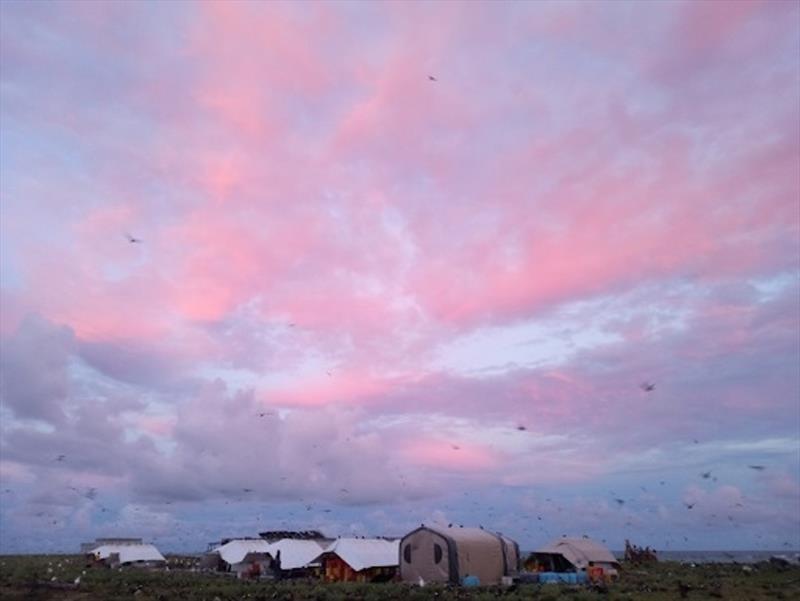
Monk seal and sea turtle research and recovery: a year in review
by NOAA Fisheries 18 May 16:59 UTC

Field camp at sunrise on Tern Island, Lalo © NOAA Fisheries
Monitoring and population assessment field camps are the foundation of NOAA's research and recovery efforts for Hawaiian monk seals and Hawaiian green sea turtles (honu) in the Papahanaumokuakea Marine National Monument.
In 2024 these annual, highly remote field camps were established in the monument at four sites:
- Lalo (French Frigate Shoals)
- Kamole (Laysan Island)
- Kapou (Lisianski Island)
- Manawai (Pearl and Hermes Atoll)
As we prepare for our 2025 field camps, we look back on the important work done in 2024.
Protecting and recovering marine species is a core mission of NOAA Fisheries. Time in the field is important for that mission to succeed. Approximately 75 percent of the endangered Hawaiian monk seals and 96 percent of the honu population call these remote islands home. Field camps not only allow researchers the opportunity to gather important data, but also to conduct life-saving interventions when appropriate to increase survival. During the 2024 season, field teams freed more than 450 turtles and 33 seabirds from aging infrastructure on Tern Island. They disentangled two turtles from a net mass anchored on a reef at Manawai and conducted 26 Hawaiian monk seal survival interventions.
Honu highlights at Lalo
Monitoring honu during summertime nesting months at Lalo helps NOAA researchers better understand their population. Honu nest on multiple islands at Lalo, so the researchers split their time between the two primary nesting sites at Tern and East islands. As a result of their hard work, the turtle team had huge successes in 2024:
- Identified 1,260 turtles at Lalo (of these, 512 females were identified on Tern Island and 223 females on East Island)
- Aided more than 450 green sea turtles on Tern Island during daily entrapment walks (326 adult turtles, 1 juvenile, and more than 130 hatchlings)
- Recovered previously unknown migration and habitat data from four expired honu satellite tags. Satellite tags typically remain attached for about 1 year, but remarkably three of the recovered tags were from 2019 and 2021!
For the first time, researchers only studied the honu while they basked during the day, instead of at night when they lay their eggs. Basking, or resting on land, is a behavior unique to turtles in only three locations around the world. It offers marine turtle scientists a way of studying turtles with minimal disturbance. The team chose to survey this way after a review of previous seasons showed that almost all nesting females were observed and available for tagging on the beach during daylight hours. By eliminating long overnight surveys this season, the team was able to increase their survey efforts of other islets in the atoll. Important nesting measurements, such as nest success, will be captured again during nighttime surveys in the future.
Hawaiian monk seal highlights
At least 169 pups were born at the six major pupping sites within Papahanaumokuakea. We carried out a total of 26 interventions that benefitted monk seal survival, including:
- 4 seals disentangled from debris
- 14 weaned pups translocated away from areas with high shark predation at Lalo
- 1 compromised seal administered medication
- 3 seals in need of rehabilitation identified and captured
- 4 nursing seal pups reunited with their mothers
Notably, we found two seals previously rehabilitated at the Marine Mammal Center's Ke Kai Ola facilities as pups in 2014 and 2019 with pups of their own this year. This highlights the importance of rehabilitation efforts on the species' recovery. We rescued three malnourished pups from Manawai in August. The ship-based scientific team provided supportive care during their transport to Ke Kai Ola for long-term rehabilitation. Additionally, we transported an adult male monk seal to Kamole and released it there during the deployment cruise to mitigate dangerous interactions with divers off the Kona coast.
Partnering to protect
NOAA Fisheries expanded 2024 efforts to pool resources with those from external partners by deploying joint field camps at three locations:
- U.S. Fish and Wildlife Service staff at Lalo
- Papahanaumokuakea Marine Debris Project staff at Kamole
- U.S. Fish and Wildlife Service staff at Manawai
Working with these partners, along with State of Hawai'i Department of Land and Natural Resources research biologists, increases coverage for surveys at Nihoa, Kuaihelani (Midway Atoll), Holaniku, and Manawai, respectively. Field teams supported research by other groups, including conducting Laysan Duck surveys at Kamole on behalf of the U.S. Fish and Wildlife Service and staging marine debris to pick up for the Papahanaumokuakea Marine Debris Project. The shared seal and turtle camp on Tern Island at Lalo included two U.S. Fish and Wildlife Service technicians. They were embedded in the camp in order to make preparations for a U.S. Environmental Protection Agency-led contaminant cleanup project in October.
Additionally, Native Hawaiian cultural practitioners and scientists with specific knowledge about mano (sharks) were integrated into the Lalo camp recovery mission. Building relationships and exchanging knowledge is important for comprehensively addressing conservation challenges and questions such as the shark predation threat to monk seal pups.
The opportunity to build upon more than 40 years of population monitoring and provide life-saving interventions supports the recovery of these charismatic species. But the researchers aren't done yet! We are preparing for the upcoming field season and look forward to sharing highlights along the way. Stay tuned!